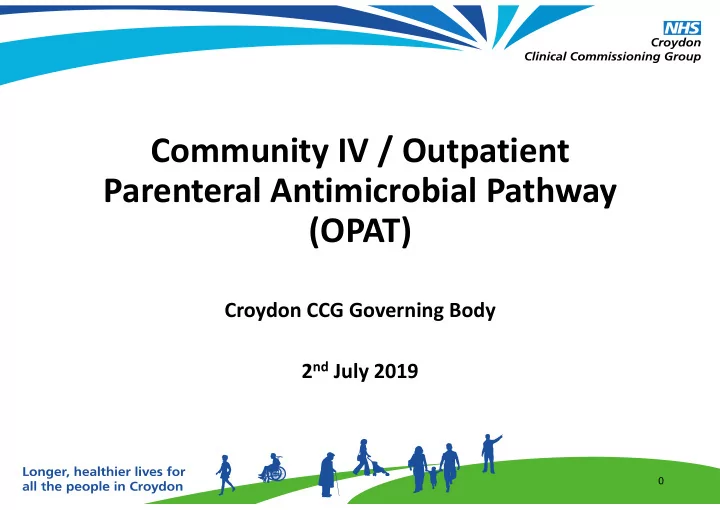

Community IV / Outpatient Parenteral Antimicrobial Pathway (OPAT) Croydon CCG Governing Body 2 nd July 2019 0
Background • Benchmarking data for Croydon CCG identified ambulatory care sensitive conditions related to infections and sepsis as areas of opportunity. • Recommendations included the development of a model for the provision of IV antibiotics in the community • Feedback from clinical teams identified: o many patients could have their treatment provided either orally, or if IV is required, through ambulatory care / home o Delays to Line insertions o the need for improved approach for ongoing oversight and review • the local OPAT pathway did not meet the best practice guidance • Croydon Health Services is also identified as a high user of antibiotics compared with other similar NHS Trusts:
Antibiotic usage - highest users, top 20 non-teaching Trusts in England (2017/18)
Current Pathway: • In 2019/20: • 9,536 patients received IV antibiotics as an inpatient at CUH o Total of 97,540 bed days (average length of stay 10.4 days) o NB – many of these admissions / durations of stay were for multiple conditions or needs o Audit demonstrated that 8.21% of inpatients reviewed could have received their IV antibiotics in another care setting • 430 patients were treated with IV antibiotics in the ambulatory emergency care unit o Majority of referrals were from A&E or GP o Small number of patients care transferred from ward setting o Audit demonstrated good impact of this existing pathway but opportunity for reducing length of treatment • 78 patients transferred from CUH inpatient to home based care delivered by community nursing teams
Who can have treatment at home / in a clinic? • Shared treatment agreement– patient, carer and clinician • Individualised treatment – meet patient needs • However, the following people cannot receive treatment through the community IV pathway: o Where the patient has no fixed abode o Where a risk assessment identifies that the home environment is not suitable for the administration of IV medication o IV drug users o Residents of nursing homes
Benefits of the new pathway for Patients: • Feedback from patients in other OPAT services has shown that they would choose it again rather than a prolonged hospital stay. o allows maintenance of independence, being with their family and friends or even returning to work. • We expect to see the following benefits for patients: o Improved patient satisfaction, o Decreased Hospital acquired infection including Clostridium difficile o Reduced length of stay or avoiding the need for admission completely o Prevents social / psychological problems associated with admission o Allows choice of therapy to suit individual needs o Delivery of care in greater comfort and privacy o More rapid return to normality (work, education)
Benefits of the new pathway – System: • Reduced inpatient stay, easing bed pressure and allowing bed reduction or reconfiguration: • Improved efficiency of resource use including impact on waiting times • Reduced hospital staff workload • Consistent specialist infection input into patient care • Reduction in healthcare associated infection • Admission avoidance for some infections • OPAT services have repeatedly been shown to be cost effective and to provide significant cost savings in the form of bed days:
Progress to date • Working jointly with clinical leads across the CCG and Croydon Health Services • Audits undertaken to identify potential opportunity • Phase 1 business case approved; including: o Additional consultant microbiologist support (commencing 2 nd July 2019) o Additional antimicrobial pharmacist (recruitment in progress) o Refurbishment of clinical space within interventional radiology to provide an ultrasound intervention lab to support reduction in time to line insertion • Pathway developed and agreed by CCG Clinical Leadership Group and One Croydon Alliance Professional Cabinet. • Phased approach developed to support smooth transfer of patients from one care setting to another and to support clinical engagement. • Engagement with patients and the public in progress to inform pathway implementation and development of patient literature.
Implementation Timeline Phase 1 Phase 2 Phase 3 Commenced 10 th June 2019 Planned start date – Planned start date – Spring September 2019 2020 • MDT support to Ambulatory Care – led by the Consultant • Implementation of full OPAT • Implementation of a self- Microbiologist/ Lead team including 2 nurse roles administration pathway Antimicrobial Pharmacist • Oversight and review of • Providing more independence • Patient review, optimisation inpatients and flexibility for patients of IV therapy and transfer to • Transfer of care into • Implementation timeline and oral treatments. ambulatory care or home pathway to be developed. • Protocol driven approach for • Reduced average waiting referral from A&E to reduce times for line placement admissions • Additional community nurse capacity
New pathway (Phase 2)
Next Steps • Final business case approval for phase 2 (July 2019) • Evaluation of phase 1 • Implementation and evaluation of phase 2 - through monitoring of the OPAT National Outcomes Registry Service requirements and definitions: o Total number of patient Episodes o Total number of Treatment Days Saved for the quarter o The total number of Line Events o The total number of Drug Events o Infection outcome by disease – cured / improved / failed o OPAT outcome - success / partial / failed / indeterminate • Development of phase 3 – self administration
Recommend
More recommend